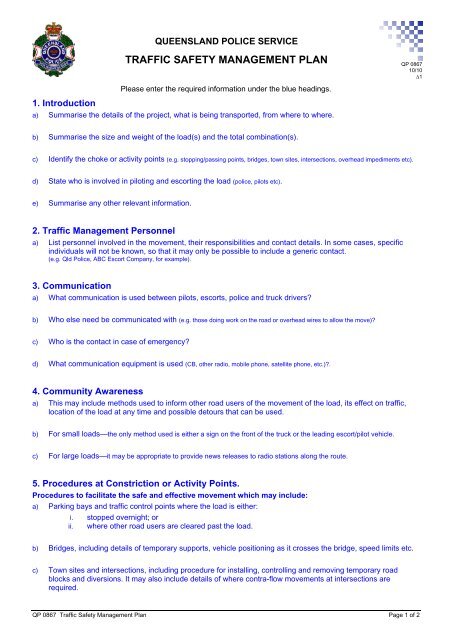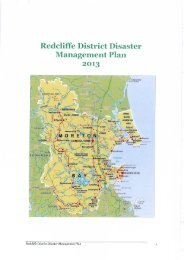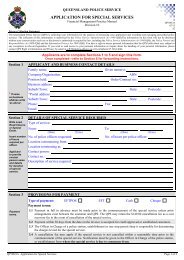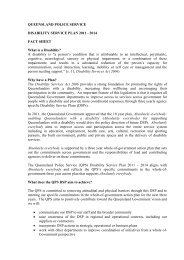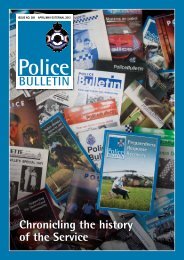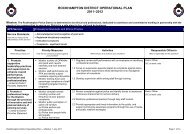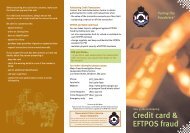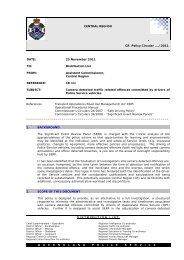TRAFFIC SAFETY MANAGEMENT PLAN - Queensland Police Service
TRAFFIC SAFETY MANAGEMENT PLAN - Queensland Police Service
TRAFFIC SAFETY MANAGEMENT PLAN - Queensland Police Service
Create successful ePaper yourself
Turn your PDF publications into a flip-book with our unique Google optimized e-Paper software.
QUEENSLAND POLICE SERVICE<br />
1. Introduction<br />
<strong>TRAFFIC</strong> <strong>SAFETY</strong> <strong>MANAGEMENT</strong> <strong>PLAN</strong><br />
QP 0867<br />
10/10<br />
1<br />
Please enter the required information under the blue headings.<br />
a) Summarise the details of the project, what is being transported, from where to where.<br />
b) Summarise the size and weight of the load(s) and the total combination(s).<br />
c) Identify the choke or activity points (e.g. stopping/passing points, bridges, town sites, intersections, overhead impediments etc).<br />
d) State who is involved in piloting and escorting the load (police, pilots etc).<br />
e) Summarise any other relevant information.<br />
2. Traffic Management Personnel<br />
a) List personnel involved in the movement, their responsibilities and contact details. In some cases, specific<br />
individuals will not be known, so that it may only be possible to include a generic contact.<br />
(e.g. Qld <strong>Police</strong>, ABC Escort Company, for example).<br />
3. Communication<br />
a) What communication is used between pilots, escorts, police and truck drivers?<br />
b) Who else need be communicated with (e.g. those doing work on the road or overhead wires to allow the move)?<br />
c) Who is the contact in case of emergency?<br />
d) What communication equipment is used (CB, other radio, mobile phone, satellite phone, etc.)?.<br />
4. Community Awareness<br />
a) This may include methods used to inform other road users of the movement of the load, its effect on traffic,<br />
location of the load at any time and possible detours that can be used.<br />
b) For small loads—the only method used is either a sign on the front of the truck or the leading escort/pilot vehicle.<br />
c) For large loads—it may be appropriate to provide news releases to radio stations along the route.<br />
5. Procedures at Constriction or Activity Points.<br />
Procedures to facilitate the safe and effective movement which may include:<br />
a) Parking bays and traffic control points where the load is either:<br />
i. stopped overnight; or<br />
ii. where other road users are cleared past the load.<br />
b) Bridges, including details of temporary supports, vehicle positioning as it crosses the bridge, speed limits etc.<br />
c) Town sites and intersections, including procedure for installing, controlling and removing temporary road<br />
blocks and diversions. It may also include details of where contra-flow movements at intersections are<br />
required.<br />
QP 0867 Traffic Safety Management Plan Page 1 of 2
d) Overhead impediments, including powerlines over the route and how these are to be treated<br />
(e.g. lifted or removed/replaced and by whom)<br />
e) Other relevant situations.<br />
6. The Route<br />
a) Identify the route and actions that may be needed at the different parts of it<br />
(e.g. location of traffic control points, town sites, intersections, overhead impediments, bridges and other problem points).<br />
b) Identify the type of traffic control needed, (e.g. where oncoming traffic must be stopped to allow the load past, where the route is<br />
wide enough for oncoming traffic to be allowed to pass).<br />
QP 0867 Traffic Safety Management Plan Page 2 of 2


